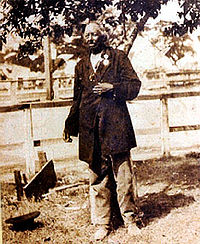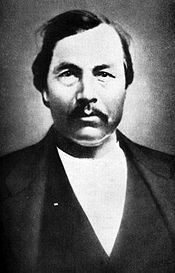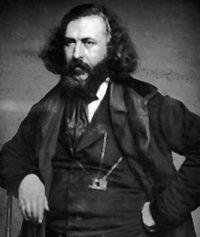- Choctaw in the American Civil War
-
Main article: Choctaw
Choctaw in the American Civil War participated in two major arenas- East and West. General Arnold Spann organized the first battalion of Choctaws in Mississippi, and Albert Pike conducted treaty terms and later commanded a combined force of Choctaw; Cherokee; Chickasaw; Creek; and Seminole troops.
Contents
Background
At the beginning of the American Civil War, Albert Pike was appointed as Confederate envoy to Native Americans. In this capacity he negotiated several treaties, one such treaty was the Treaty with Choctaws and Chickasaws conducted in July 1861. The treaty covered sixty-four terms covering many subjects like Choctaw and Chickasaw nation sovereignty, Confederate States of America citizenship possibilities, and a entitled delegate in the House of Representatives of the Confederate States of America .
Soon Confederate battalions were formed in Indian Territory and later in Mississippi in support of the southern cause. The Choctaws, who were expecting support from the Confederates, got little. Webb Garrison, a Civil War historian, describes their response: when Confederate Brigadier General Albert Pike authorized the raising of regiments during the fall of 1860, Creeks, Choctaws, and Cherokees responded with considerable enthusiasm. Their zeal for the Confederate cause, however, began to evaporate when they found that neither arms nor pay had been arranged for them. A disgusted officer later acknowledged that "with the exception of a partial supply for the Choctaw regiment, no tents, clothing, or camp and garrison equippage was furnished to any of them."[1]
East
 Jack Amos, seen here at age 77, was a private of the First Choctaw Battalion in Mississippi, CSA
Jack Amos, seen here at age 77, was a private of the First Choctaw Battalion in Mississippi, CSA
The Confederacy wanted to recruit Indians east of the Mississippi River in 1862, so they opened up a recruiting camp in Mobile, Alabama "at the foot of Stone Street."[2] The Mobile Advertiser and Register would advertise for a chance at military service.
“ A Chance for Active Service. The Secretary of War has authorized me to enlist all the Indians east of the Mississippi River into the service of the Confederate States, as Scouts. In addition to the Indians, I will receive all white male citizens, who are good marksmen. To each member, Fifty Dollars Bounty, clothes, arms, camp equipage &c: furnished. The weapons shall be Enfield Rifles. For further information address me at Mobile, Ala. (Signed) S.G. Spann, Comm'ing Choctaw Forces. ” —Jacqueline Anderson Matte, They Say the Wind is Red[2]
General Arnold Spann organized the first battalion of Choctaws in Mississippi in February 1863.[3] After a train wreck, referred to as the Chunky Creek Train Wreck of 1863, near Hickory, Mississippi, the Choctaw Battalion, which had been organized days earlier, led rescue and recovery efforts. Spann described the scene, "the engineer was under military orders, and his long train of cars was filled with Confederate soldiers, who, like the engineer, were animated with but one impulse—to Vicksburg! To victory or death! Onward rushed the engineer. All passed over except the hindmost car. The bridge had swerved out of plumb, and into the raging waters with nearly one hundred soldiers the rear car was precipitated. 'Help!' was the cry, but there was no help."[4] Boggan writes of the rescue, "help came quicker than expected. The First Battalion of Choctaw Indians, under the command of Major S. G. Spann, was based at a Confederate military training camp near the crash scene. Led by Jack Amos and Elder Williams, the Indians rushed to the scene, stripped, and plunged into the flooded creek. Many of the passengers were rescued due to their heroic acts."[5] Noted Choctaw Historian Clara Kidwell writes, "in an act of heroism in Mississippi, Choctaws rescued twenty three survivors and retrieved ninety bodies when a Confederate troop train plunged off a bridge and fell into the Chunky River."[3]
Major S. G. Spann, Commander of Dabney H. Maury Camp of Meridian, Mississippi, wrote about the deeds of the Choctaw years after the Civil War had ended.[4]
“ Many earnest friends and comrades insist that the Choctaw Indian as a Confederate soldier should receive his proper place on the scroll of events during the American Civil War. This task having been so nearly ignored, I send some reminiscences that will be an exponent of the extraordinary merit of the Choctaw Indian on the American Continent. My connection with the Choctaw Indians was brought about incidentally: Maj. J.W. Pearce, of Hazelhurst, Miss., organized a battalion of Choctaw Indians, of Kemper, DeKalb, Neshoba, Jasper, Scott], and Newton Counties, Miss., known as "First Battalion of Choctaw Indians, Confederate army." ” —Maj. S. G. Spann- Confederate Veteran Magazine Volume XIII
Mississippi Choctaws captured
Mississippi Choctaws were captured in Ponchatoula, Louisiana, and several died in a Union prison in New York.[3] Spann describes the incident, "[Maj. J.W. Pearce] established two camps—a recruiting camp in Newton County and a drill camp at Tangipahoa—just beyond the State boundary line in Louisiana in the fall of 1862. New Orleans at that time was in the hands of the Federal Gen. B.F. Butler. Without notice a reconnoitering party of the enemy raided the camp, and captured over two dozen Indians and several noncommissioned white officers and carried them to New Orleans. All the officers and several of the Indians escaped and returned to the Newton County camp; but all the balance of the captured Indians were carried to New York, and were daily paraded in the public parks as curiosities for the sport of sight-seers.[4]
West
 Jackson McCurtain, Lieutenant Colonel of the First Choctaw Battalion in Oklahoma, CSA.
Jackson McCurtain, Lieutenant Colonel of the First Choctaw Battalion in Oklahoma, CSA.
In Choctaw Nation, Jackson McCurtain, who would later become a district chief, was elected as representative from Sugar Loaf County to the National Council in October 1859. On June 22, 1861, he enlisted in the First Regiment of Choctaw and Chickasaw Mounted Rifles. He was commissioned Captain of Company G under the command of Colonel Douglas H. Cooper of the Confederate Army. In 1862 he became a Lieutenant Colonel of the First Choctaw Battalion.[6]
Organization
The Choctaw and Chickasaw Nations were to organize ten companies. The units would participate in eight battles.
- First Choctaw and Chickasaw Mounted Rifles
- Second Regiment of Choctaw Cavalry
- Third Regiment of Choctaw Cavalry
- First Choctaw Mounted Rifles
- Regiment of Choctaw Warriors
- Company of Choctaw Infantry
Aftermath
The fate of the Mississippi Choctaw captured in Louisiana after the end of the war is unknown.
References
- ^ Garrison, Webb (1995). "Padday Some Day". More Civil War Curiosities. Rutledge Hill Press.
- ^ a b Matte, Jacqueline (2002). "Refugees- Six Towns Choctaw, 1830-1890". They Say the Wind is Red. New South Books. p. 65. ISBN 1588380793.
- ^ a b c Kidwell, Clara (1995). "The Choctaws in Mississippi after 1830". Choctaws and Missionaries in Mississippi, 1818-1918. University of Oklahoma. p. 170. ISBN 0806126914.
- ^ a b c Spann, S. G.; Confederate Veteran Magazine Volume XIII, Number 12, pages 560 and 561 (December 1905). "Choctaw Indians As Confederate Soldiers". http://www.choctaw.org/History/Conflicts%20&%20War/Choctaw%20Indians%20As%20Confederate%20Soldiers%20.html. Retrieved 2009-05-21.
- ^ Boggan, Greg (2005-02-06). "The Chunky Creek Train Wreck of 1863". http://nchgs.org/history/trainwreck/. Retrieved 2008-02-08.
- ^ "Choctaw Nation of Oklahoma: 1880 - Jackson F. McCurtain". 1880. http://www.choctawnation.com/History/index.cfm?fuseaction=HArticle&HArticleID=14. Retrieved 2008-02-08.[dead link]
Categories:- Native Americans in the Civil War
Wikimedia Foundation. 2010.

